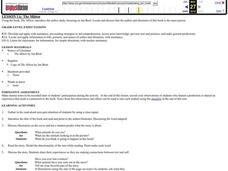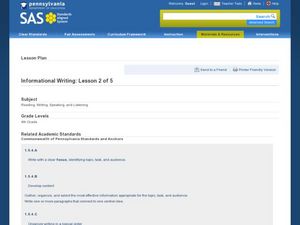Curated OER
Creating Supporting Characters
Supporting characters need detail and characteristics just like a main character. Keep your budding authors entrenched in detail as they write their novels. This lesson focuses on developing supporting characters using personal...
Curated OER
Turn the Ordinary into Something Extraordinary!
Summer writing ideas that encourage young authors to find their own writing prompts.
Curated OER
Lesson Plan 18: Art Project! Design Your Own Book Cover
Finished your novel? What’s next? Designing the book cover, of course. But how to begin? After examining the covers of published books and noting the common elements of these jackets, young novelists design a front and back cover for...
Curated OER
Write Right!
After watching part of a Club Write Kids video and discussing the editing process, each group of learners writes a letter to a favorite author. They ask for a copy of a page of manuscript that has gone through the editing process. Prior...
Curated OER
Narrative Writing vs. Explanatory Writing
The class discusses the different purposes an author has for writing. The focus of the discussion is on writing to tell a true story and writing to give information about a specific topic. There are writing purpose sorting cards embedded...
Core Task Project
Whatif by Shel Silverstein
What a skillful way to incorporate Shel Silverstein, a wonderful author, into the classroom. Composed of three tasks, children are led through a series of text-dependent questions that force them to unveil the meaning of Silverstein's...
Curated OER
Analyzing Two or More Nonfiction Texts
How does recognizing the author's purpose help you draw conclusions about a topic? Using two articles (both are attached), learners brainstorm why each author wrote each article. Are their purposes similar or different? Learners use a...
Curated OER
Create a Book with Student Treasures
You can't publish a story until after it has been revised and edited! Budding authors investigate the writing process while drafting an original story. They select a topic, complete a rough draft, edit it, revise it, and finally publish...
Curated OER
The Mitten
Explore children's literature by researching a book and it's author. Youngsters read the story The Mitten by Jan Brett and discuss the animals and characters mentioned in the story. Then, they practice retelling their favorite portion of...
Curated OER
Fabulous, Fractured Fables
Elementary schoolers develop an awareness of the literary form known as the fable. They explore how authors write fables to pass along moral lessons. After reading and discussing many famous fables embedded in the plan, learners attempt...
Teacherfiles
Character Grid
Characters are built with more than just what the author directly says about a character (ex: she is smart). Help your pupils focus on several elements of characterization with a graphic organizer that has space for two characters....
Curated OER
Study Guide for Missing May
Use this comprehensive packet to accompany a study of Missing May by Cynthia Rylant. Starting out with a brief author biography and background information about the novel, this guide includes materials to use throughout the entire novel....
Have Fun Teaching
Making Inferences (1)
Provide readers with an opportunity to practice drawing inferences by giving them this worksheet. Kids identify the text and author, record a sentence they believe infers rather than directly says, and then write the deeper meaning the...
Have Fun Teaching
Making Inferences (21)
Monstrous! But do not be afraid! These weird-looking creatures won't scare readers away from making inferences about what authors are trying to show, rather than tell their readers. Instead the toothy, bug-eyed aliens model the process...
Curated OER
Dominant Impression
Students explore author's purpose, are introduced to dominant impression, make a list of descriptive words or phrases and write from personal experience.
Curated OER
Young Author Books: I Am a Leaf on My Family Tree
Fourth graders create family tree books. They discuss culture and brainstorm interview questions for family members. They write stories, poems, and captions for family photos. They interview family members and assemble the interviews...
Curated OER
Author's Purpose
In this worksheet on determining the purpose of writing, students read 3 short paragraphs and choose whether they were written to persuade, inform or entertain.
Curated OER
Cameras and Careers
Applying photography basics they learn for this project, first graders take pictures of an adult at work focusing on the tools used, the work site, and job responsibilities. After making a career book that includes photos and...
Curated OER
Fairy Tale Book Report Form
Motivate you class with this resource. Learners read a fairy tale and then fill out this book report. They identify the name of the fairy tale, the author, the illustrator, and the setting on each of the blank lines. Then, they fill in a...
Pennsylvania Department of Education
Informational Writing: Lesson 2 of 5
Introduce expository writing to your elementary learners. Young authors write a three-paragraph informational paper using the steps of the writing process. They follow guided lessons to experience each of five steps. Included are tons of...
Read Works
Signal Words in Expository Text
Signal words are one way that authors make the relationships between their ideas clear. Allow your learners the chance to investigate cause and effect in texts by identifying signal words. They locate and analyze cause-and-effect...
Read Works
The Language of Setting
Examine the connection between descriptive language and emotional impact. For the first few chapters of The Lion, the Witch and the Wardrobe by C.S. Lewis, learners record the descriptive writing the author used to vivify the woods in...
Curated OER
Writing About Talking
The story of King Arthur is a fascinating one, and this retold excerpt offers an excellent example of narrative word choice in a dialogue. Learners read the text and examine the way the author uses synonyms for said. They write down all...
Scholastic
Story Map
Simplify a short story or novel in your language arts class with a story map. The graphic organizer includes fields such as title and author, main characters, and problem and solution.
Other popular searches
- Authors Purpose
- Author's Purpose
- Author Study
- Authors Point of View
- Authors Purpose Powerpoint
- Authors Purpose Mini Lesson
- Author Research
- Authors Purpose Passage
- Georgia Authors
- Authors Study
- Teaching Author's Purpose
- Student Authors

























